Don’t get me wrong, I actually like poinsettias.
The showy crimson blooms are a botanical trademark of the season, with a shape resembling the biblical star of Bethlehem. Nothing says Christmas more than a store display full of potted poinsettia plants and in my house, you’ll always find a poinsettia or two decorating a tabletop in December.
Read more: Keep Your Poinsettia Looking Good This Holiday Season (and Beyond)
But some people find them too fussy to care for, or maybe they prefer a less traditional choice. Luckily, there are many other festive flowers to spruce up your home through the holidays and they can be grown year-round more easily as houseplants too.
If you want to do something a little different this year, here are my favorite, often-overlooked Christmas plants that work as beautiful alternatives to poinsettias.
Disclosure: If you shop from my article or make a purchase through one of my links, I may receive commissions on some of the products I recommend.
1. Christmas cactus
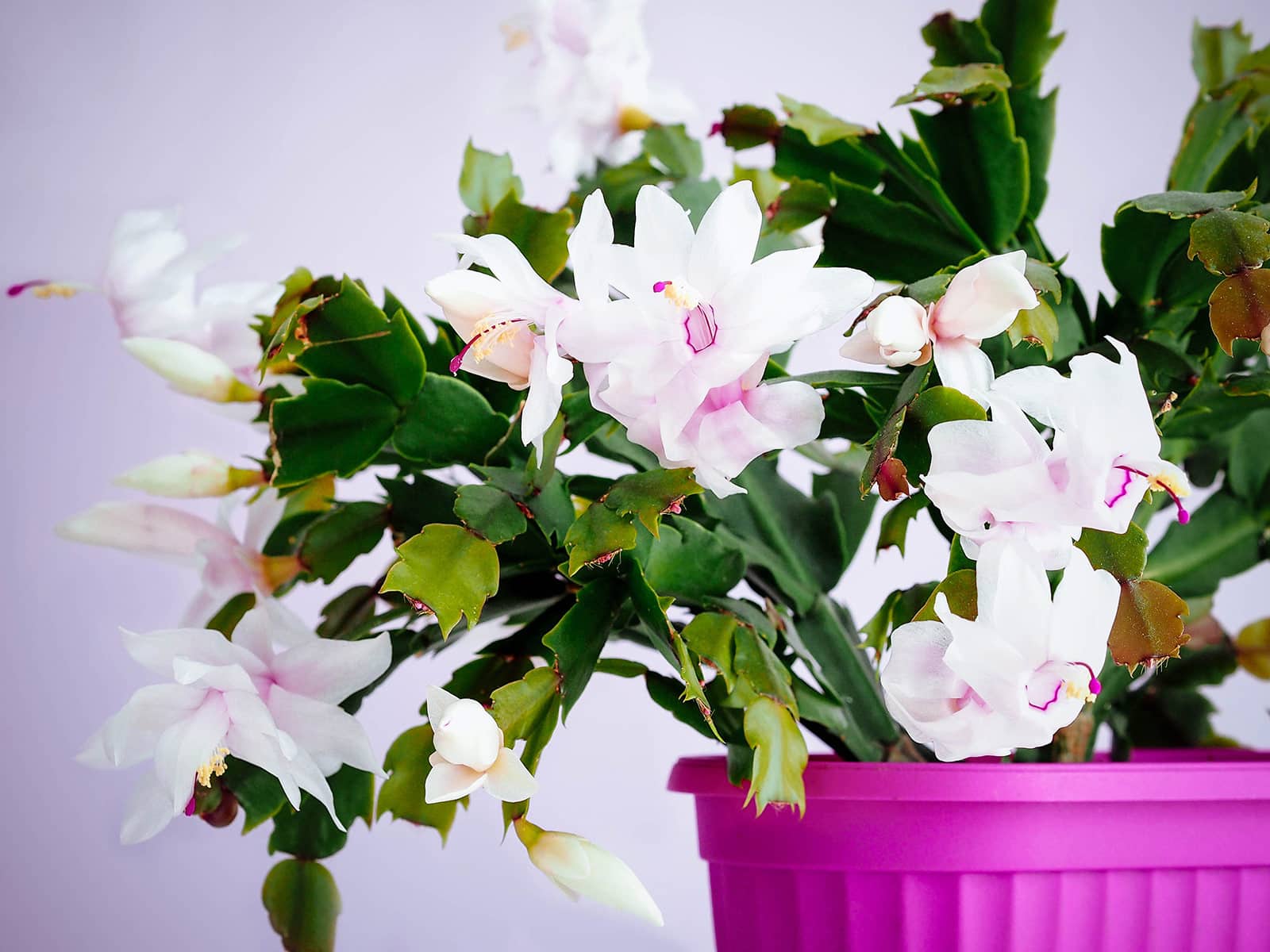
You might know Christmas cactus (Schlumbergera x buckleyi) by its other names, as the plant is also labeled in stores as Thanksgiving cactus, Easter cactus, crab cactus, or simply, holiday cactus.
While it looks like a pretty typical green succulent the rest of the year, Christmas cactus starts putting out a showstopping display of flowers in late fall in classic colors like red and pink, but also yellow, orange, or white.
Related: 9 Cactus Varieties With Amazing Flowers: Blooming Houseplants You’ll Love
With the right care (and some sneaky techniques), you can even get your Christmas cactus to bloom again in late winter to early spring, too.
How to care for Christmas cactus: Though Christmas cactus is related to its desert-dwelling succulent cousins, it’s a tropical cactus—meaning it prefers the moist conditions and filtered sunlight of its native jungle habitat.
Don’t let Christmas cactus dry out too much between waterings, and put it in a spot that gets bright indirect light.
Safe for pets? Yep, Christmas cactus is cat- and dog-friendly!
2. Cyclamen
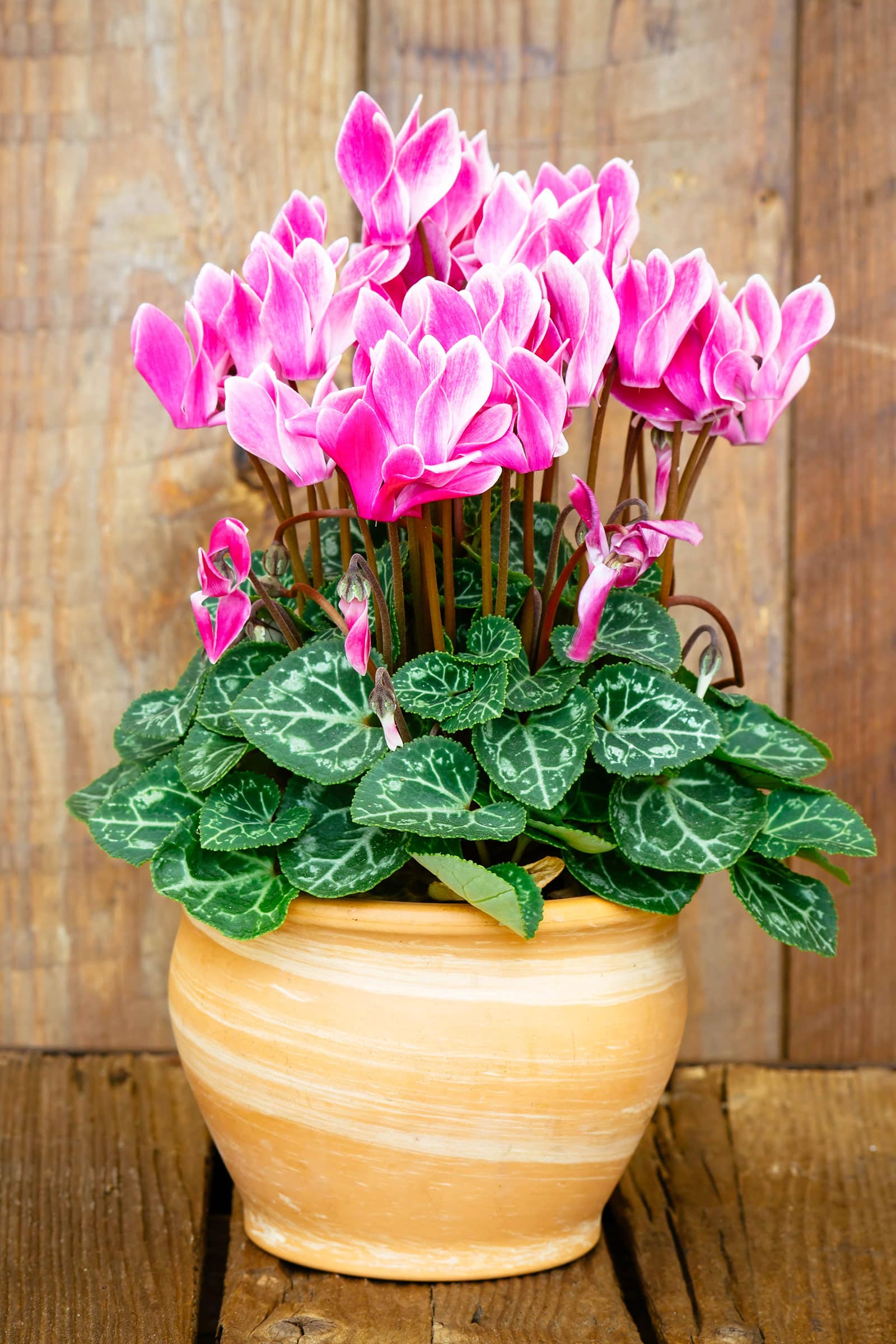
Just when many other houseplants are going dormant this time of year, Cyclamen (Cyclamen spp.) steps up in all its winter-blooming glory.
This holiday classic usually shows up in stores between Thanksgiving and Christmas with an array of leaf patterns and flower colors. You can go with a crisp white Cyclamen, or opt for brighter shades of pink, red, purple, or even a mix.
Don’t toss your Cyclamen once it’s stopped blooming—this one can live year-round as an indoor plant with minimal fuss.
How to care for Cyclamen: Cyclamen are ideal winter houseplants because they like it cool, and if you keep your thermostat between 55°F and 65°F, you’ll get long-lasting blooms for up to eight weeks.
The tuber is sensitive to rot and it doesn’t really like to get its leaves and flower wet, so make sure to bottom water your Cyclamen if the first inch or two of soil feels dry.
Safe for pets? Unfortunately, no. The triterpenoid saponin content in this plant makes it toxic to both animals and humans if ingested, so keep it away from curious pets and children.
3. Amaryllis
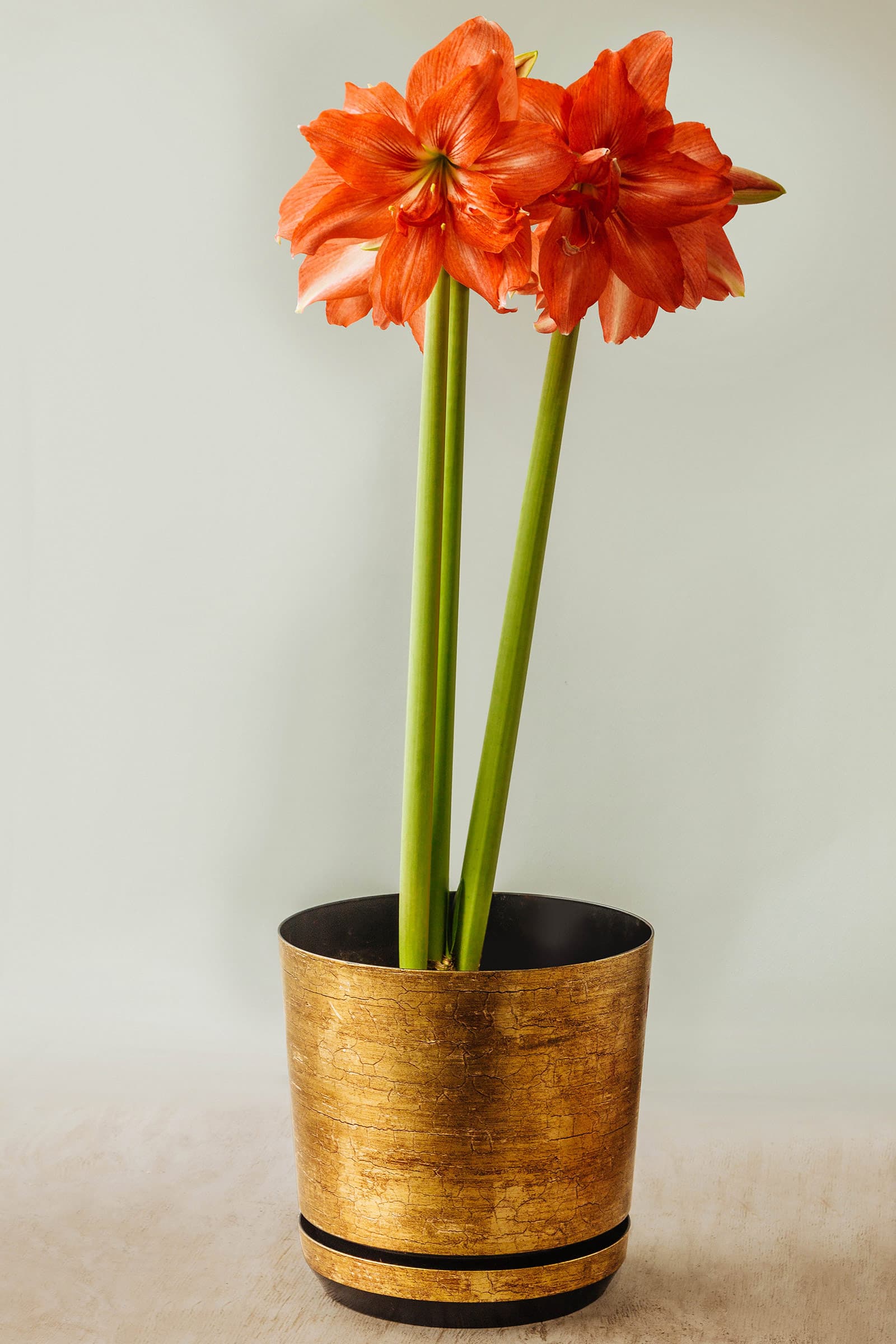
Amaryllis (Hippeastrum spp.) is a flowering bulb that often shows up in floral arrangements as just a single bulb, though larger bulbs will typically produce two or three flowering stems. Group a few bulbs together and you’ve got yourself a stunning centerpiece for the holidays!
You’ll find amaryllis as either plantable (unwaxed) or one-time use (waxed) bulbs, and in solid or striped varieties that range from red and pink to white and orange.
While they sometimes come in full bloom already, it usually takes six to eight weeks for a dormant amaryllis to begin blooming—just in time for Christmas.
How to care for amaryllis: Amaryllis bulbs are sensitive to rot, so make sure yours is planted in a well-draining potting medium and only water when the first couple inches of soil feel dry.
If the plant is happy, the blooms should last up to six weeks.
Safe for pets? No. The bulb contains poisonous alkaloids that can cause upset stomach in cats and dogs.
4. Paperwhite
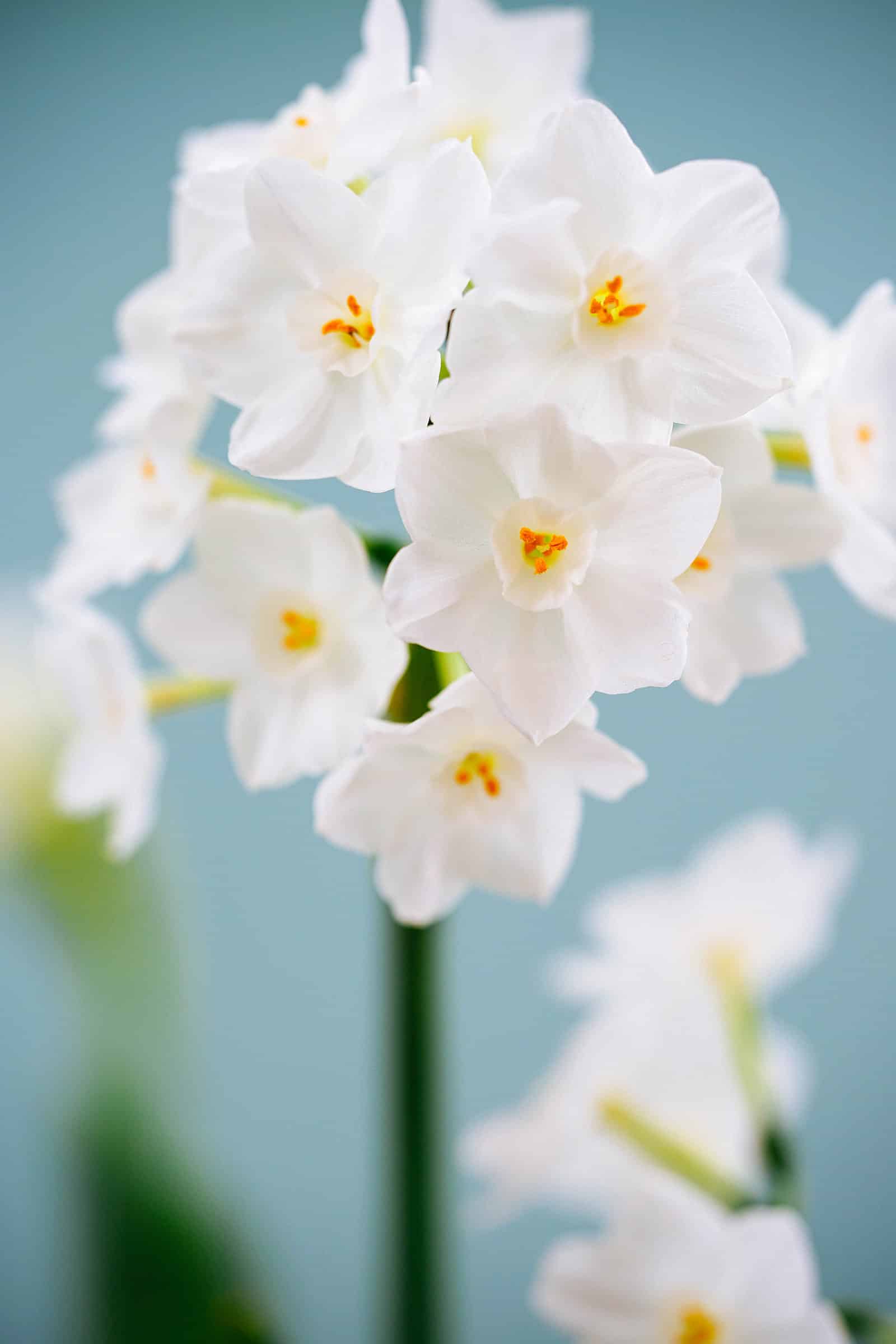
A close relative of daffodils, paperwhites (Narcissus papyraceus) are another lovely bulb that’s not as showy as some of these other options, but perfect for adding a bit of holiday cheer to a corner.
The large clusters of delicate, snow white flowers have an intoxicating, spicy fragrance and last about two weeks. Once the plant is done blooming, you can enjoy the green leaves as a houseplant for a few more weeks.
How to care for paperwhite: Paperwhites prefer a cool environment (50°F to 60°F is ideal) and don’t like to sit in soggy soil.
Place your pot near a sunny window and keep the soil lightly moist until the leaves die back. (Paperwhites won’t bloom again indoors.)
Safe for pets? No. The bulb is the most dangerous part of the bulb and can cause severe reactions in cats and dogs if a large amount is eaten.
5. Azalea
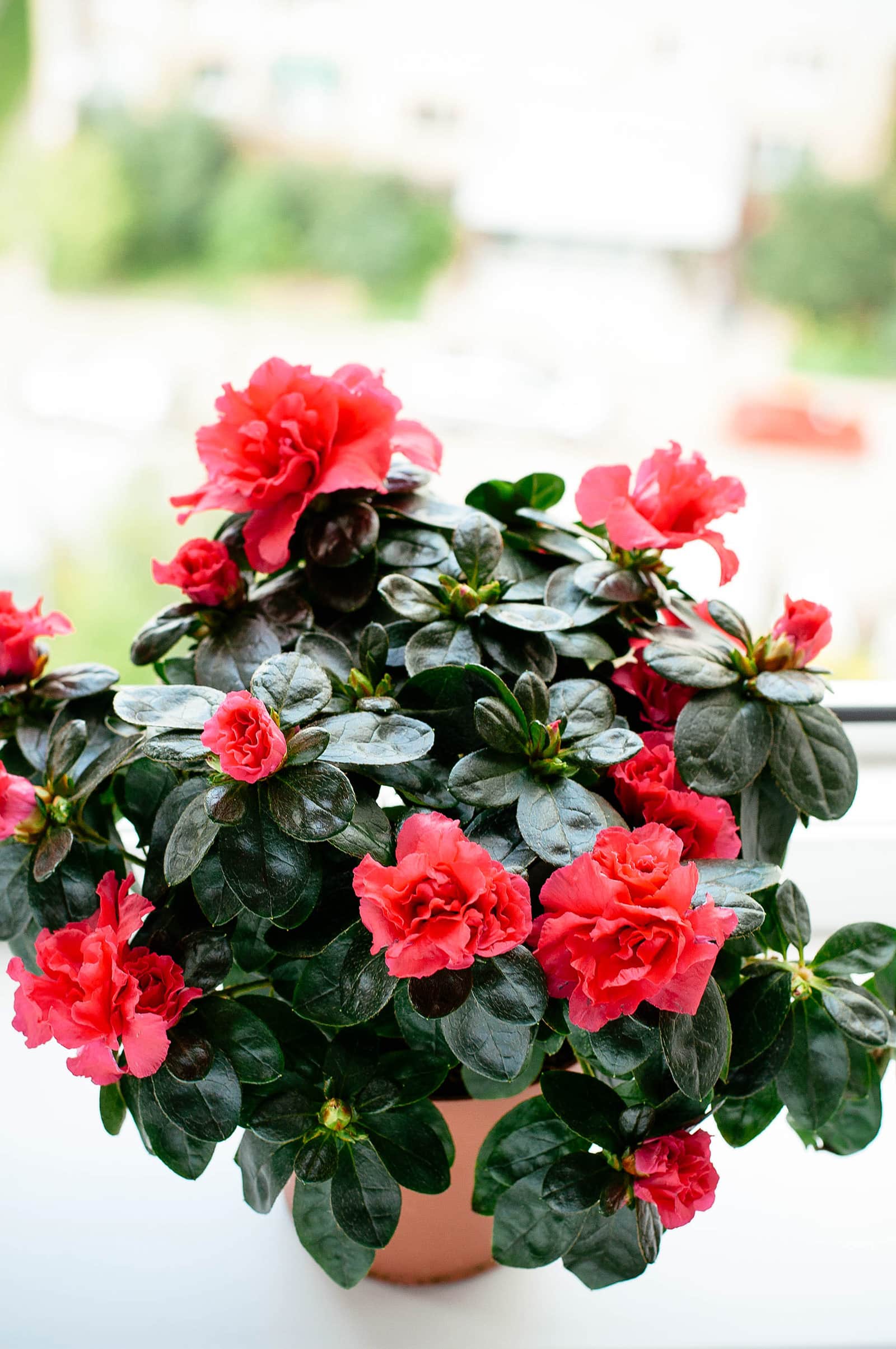
Azaleas (Rhododendron spp.) are popular holiday houseplants since they thrive in cool temperatures and have long-lasting blooms (three to four weeks).
The delicately ruffled flowers appear in vivid shades of red, purple, pink, coral, and white.
While azaleas can be grown outside (these varieties are known as “hardy azaleas”), the potted azaleas you’ll find for sale this time of year are evergreen azaleas that have been grown in a greenhouse and forced to bloom in December. They grow smaller and are more suitable for homes than their shrubby outdoor counterparts.
How to care for azalea: Azaleas are happiest when it’s cool inside: in the 50s (Fahrenheit) at night and not above 68°F during the day. Keep the plant in a bright location away from direct sun, and water when the first inch of soil feels dry.
If you want your azalea to bloom again next year, it will need about six weeks of nighttime temps between 40°F and 55°F to form buds.
Safe for pets? All parts of azaleas are toxic to cats and dogs and produce serious gastrointestinal issues (potentially even death) if ingested.
Shop now for evergreen azaleas
6. Anthurium
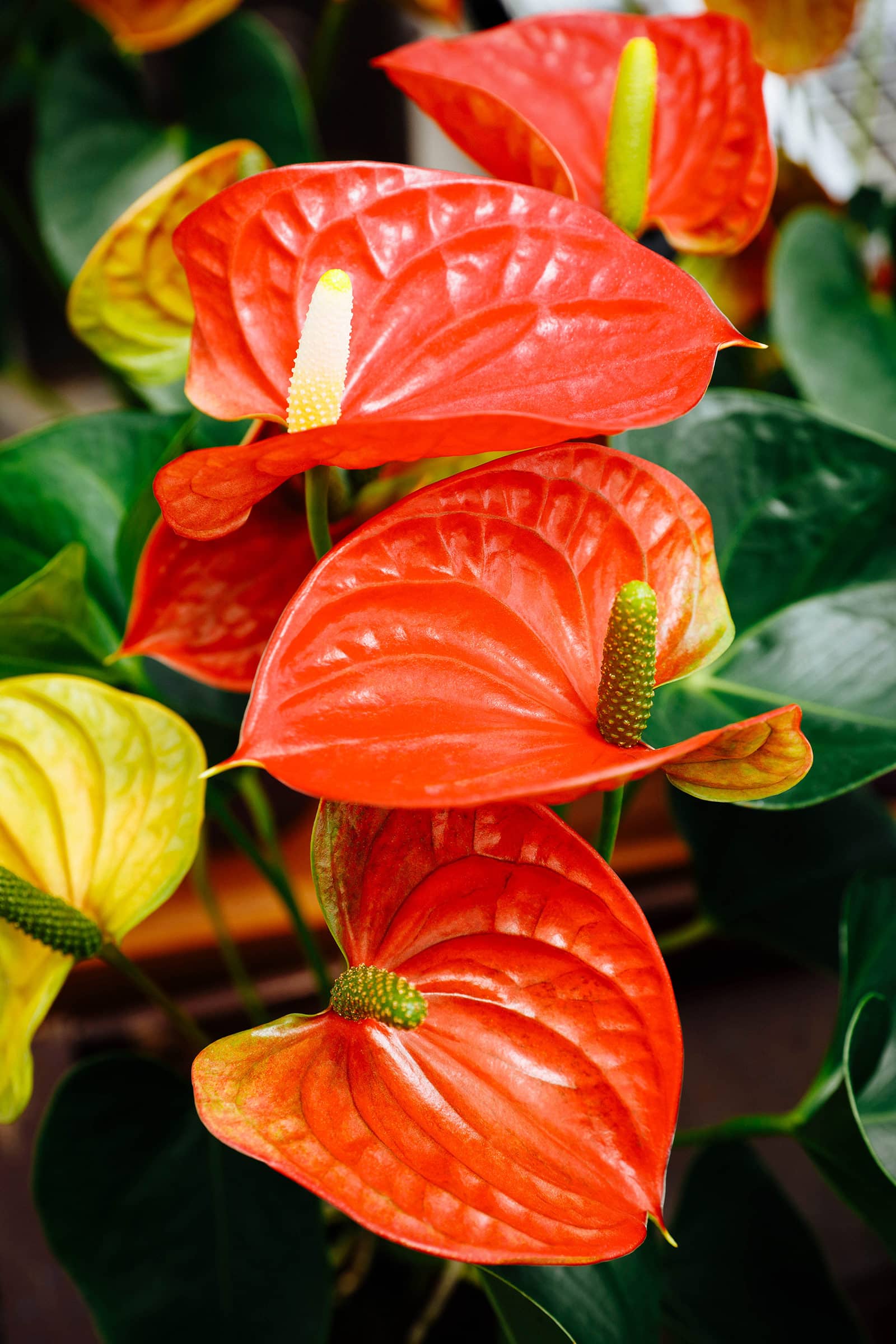
Easy-care Anthurium (Anthurium andraeanum) is not only a striking houseplant for the holidays, but for any time of year. It comes in a dizzying array of colors thanks to mass hybridization and is a prolific bloomer, producing flowers for much of the year.
In fact, if your Anthurium hasn’t put out any flowers for a couple of months, it means you’ve probably neglected it!
The waxy flowers also make beautiful cut flowers for bouquets and last quite long in a vase.
How to care for anthurium: As a jungle plant, Anthuriums thrive in in bright indirect light and lightly moist soil.
To encourage blooming, apply a diluted liquid houseplant fertilizer in the spring and summer months when your plant is actively growing.
Safe for pets? The calcium oxalate content in Anthurium causes irritation in the form of rashes, swelling, and burning sensations. It’s best to keep this plant away from pets.
7. African violet
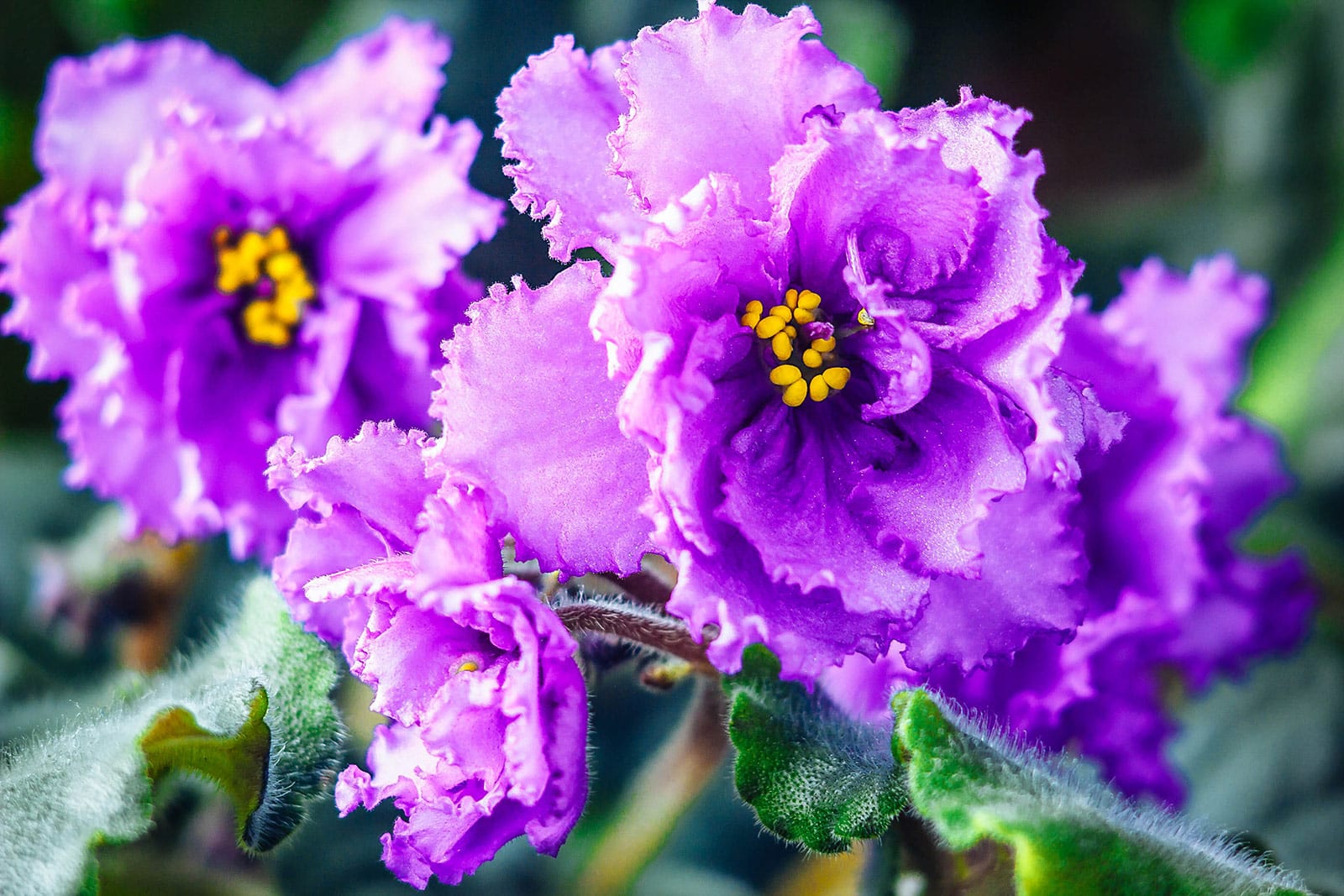
Do you remember your mother or grandmother growing a few of these fuzzy plants on their windowsill?
This classic American houseplant has a heartwarming tradition as a Mother’s Day or Valentine’s Day gift, but there’s no reason it can’t be a Christmas centerpiece as well.
African violets (Saintpaulia spp.) flower almost constantly and the white and crimson varieties are especially well-suited for the holidays, though you can take your pick from any shade of purple, pink, or blue, in rosette or trailing varieties and in miniature or standard sizes.
How to care for African violet: The main thing to remember about African violets is that they don’t like cold water and they don’t like their leaves getting wet.
Keep the soil lightly moist and bottom water with lukewarm or room temperature water for best results.
Safe for pets? Absolutely! African violets are a great choice for households with animals.
8. Kalanchoe
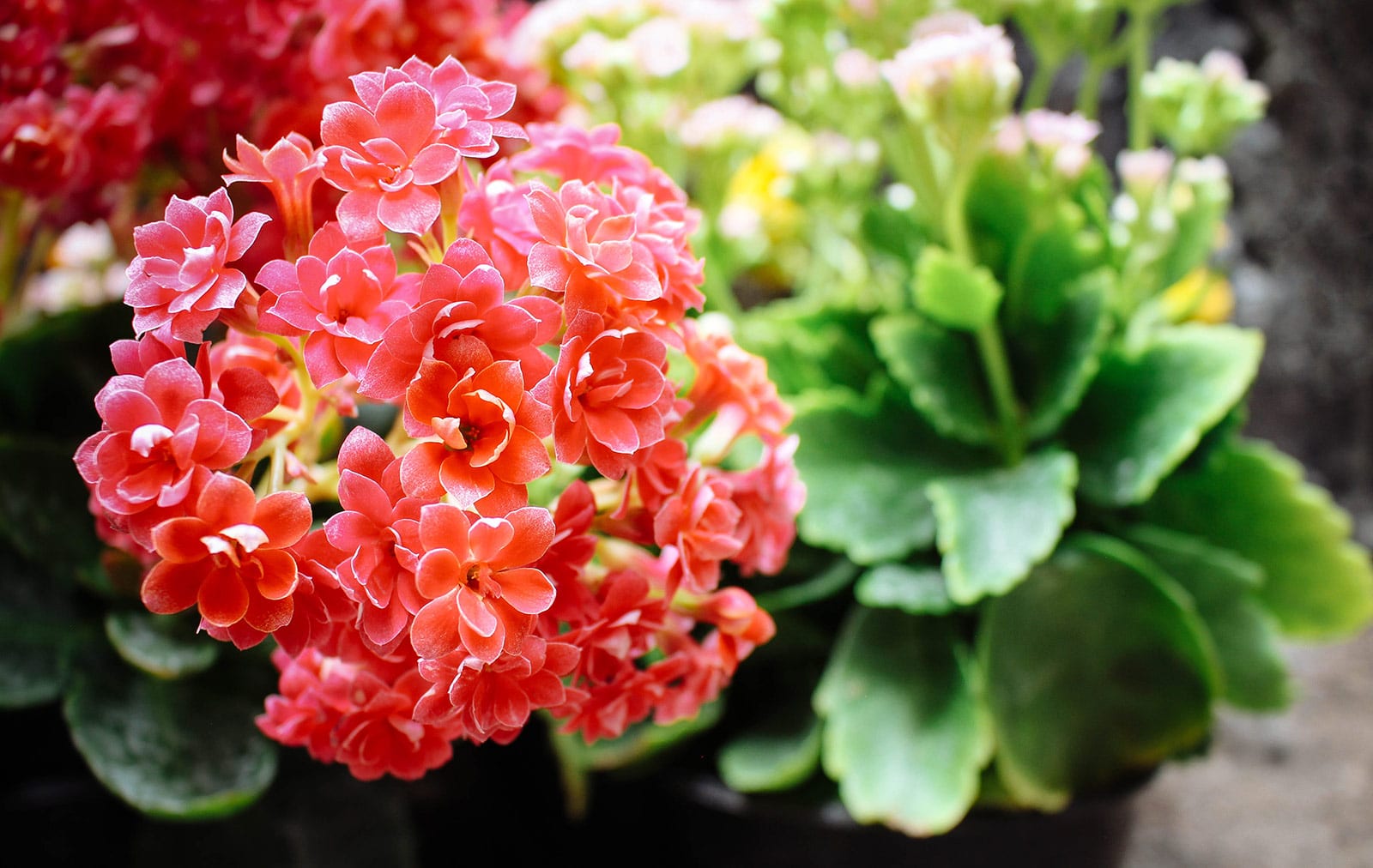
This colorful succulent (sometimes called a Christmas Kalanchoe) is easy to grow as a houseplant, and it has umbels of flower clusters with an especially long bloom period (up to eight weeks) when compared to other succulents.
Kalanchoe (Kalanchoe blossfeldiana) can even bloom again and again if given the right care and light exposure.
The key to a repeat bloom? Give the plant at least 14 hours of darkness each day for about six weeks. This “winter darkness” period resets the bloom cycle and tricks your Kalanchoe into blooming nearly year-round.
How to care for Kalanchoe: Kalanchoe enjoys abundant bright light, but try to avoid placing it in direct sun, which can scorch the leaves.
It does well with minimal water (making it a perfect choice for forgetful plant keepers) and requires a complete saturation only once every few weeks when the soil goes bone dry.
Safe for pets? Unfortunately, no. All parts of Kalanchoe are toxic to cats and dogs.
Shop now for Christmas Kalanchoe
9. Phalaenopsis orchid
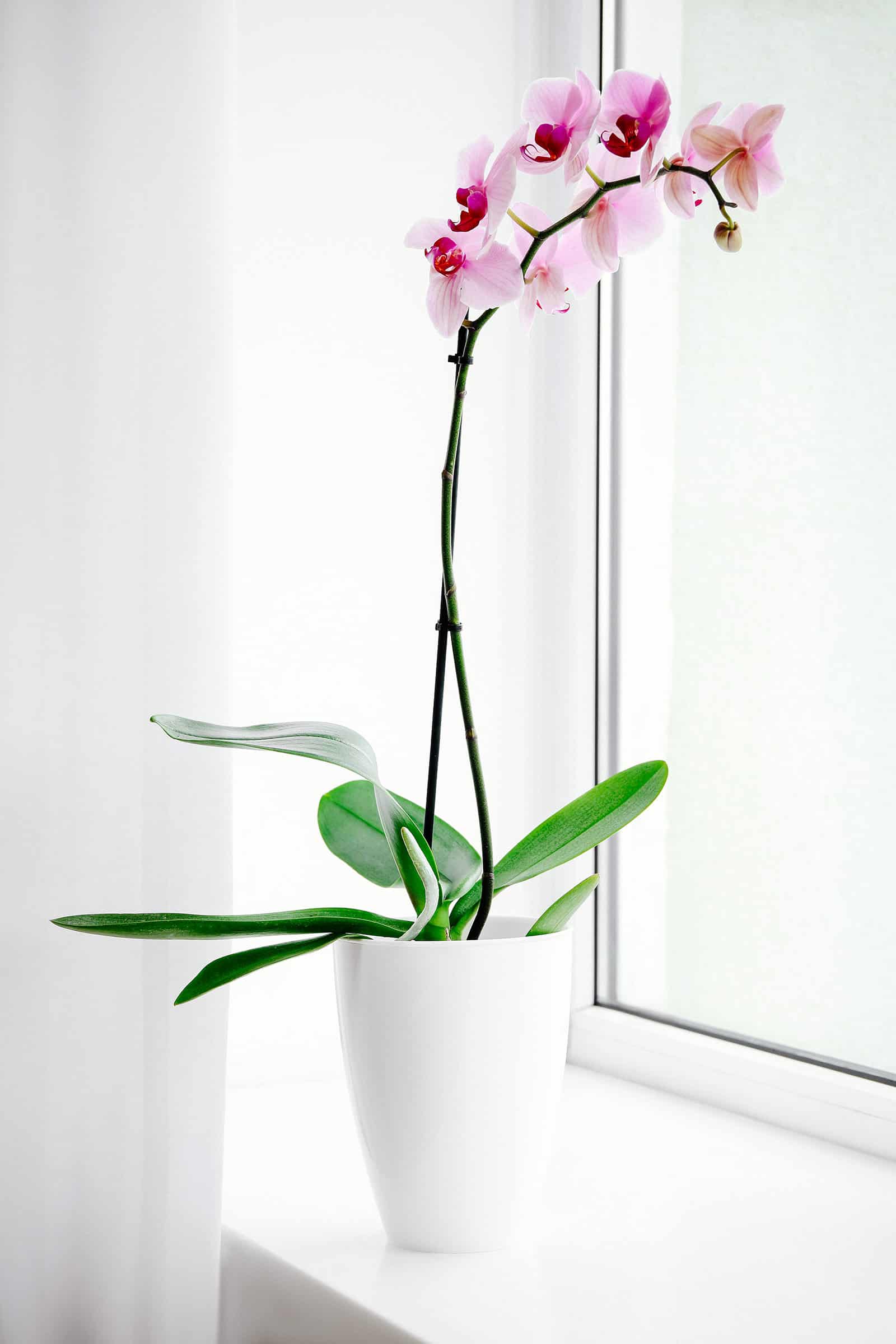
Often called the beginner orchid since it’s one of the easiest varieties of orchids to grow as a houseplant, Phalaenopsis orchid (Phalaenopsis spp.) lends an air of elegance to the holidays with its graceful, arching branches and long-lasting, flat flowers.
A single, multi-branching flower spike can have nearly two dozen flowers that bloom for a month or more!
While the frosty white variety is most commonly found in stores, Phalaenopsis orchids also come in beautiful combinations of purple, red-purple, violet, purple-violet, blue-violet, pink, and salmon.
How to care for Phalaenopsis orchid: In winter, this houseplant is happiest in a south- or east-facing window in warm temperatures between 75°F and 85°F (though it can adapt to slightly cooler house temps as well—just don’t let the thermostat drop below 65°F at night).
During the growing season, water your Phalaenopsis orchid weekly or when the exposed roots turn silvery white. Simply run lukewarm water over the aerial roots for several minutes, giving them enough time to absorb moisture, and make sure the water is fully drained before returning your orchid to its window.
Safe for pets? Yes! Phalaenopsis orchids are totally pet-friendly.
Shop now for Phalaenopsis orchids
10. Rosemary

Rosemary is often potted and pruned into a A-line shape during the holiday season to mimic a potted Christmas tree.
It’s an herbaceous perennial that does double duty, since you can use a few sprigs for your winter stews and you can even decorate your rosemary “tree” if you don’t have space for a traditional Christmas tree.
Rosemary is one of my favorite choices for an indoor plant as the strong, pine-like fragrance makes my home smell like Christmas, and it’s super fresh and invigorating in the winter months. (The smell of rosemary is even said to make you smarter! So, it’s a great houseplant to keep on your desk.)
How to care for rosemary: Rosemary likes full sun, so it will thrive in a bright, south-facing window. Check the soil with your finger once or twice a week to see if it needs water.
If the top 2 inches of soil feels dry, give it a drink (but don’t let the roots get waterlogged).
Safe for pets? Not only is rosemary completely safe to keep around pets, a small amount of rosemary added to your dog’s food can actually be beneficial to its health.
Shop now for potted Christmas rosemary
View the Web Story on best holiday houseplants.
















Your article are very good.
Thanks so much for including the pet safety info in this list!